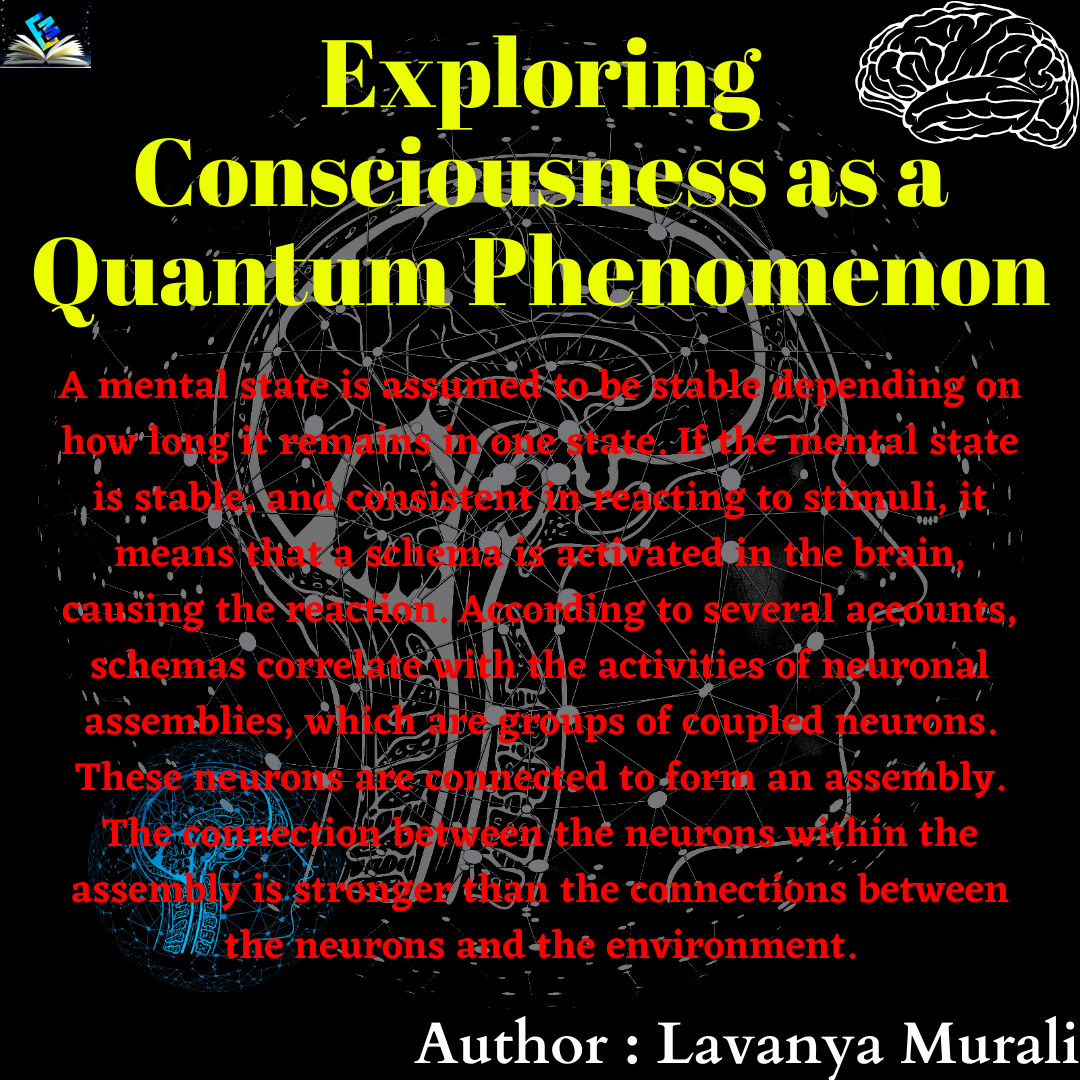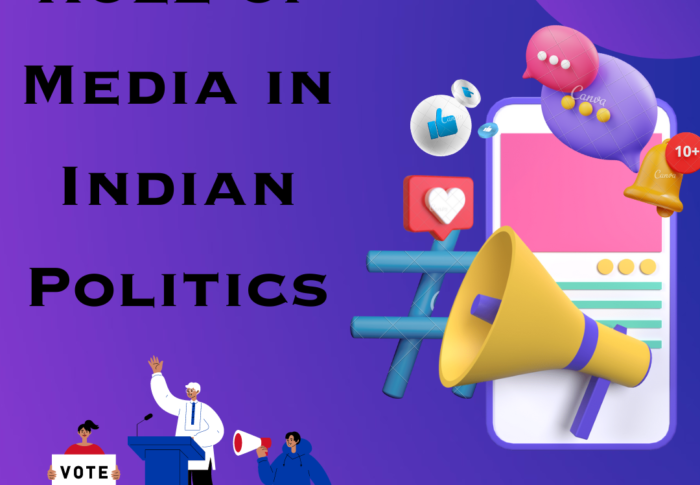
Exploring Consciousness as a Quantum Phenomenon
Consciousness : A mental state is assumed to be stable depending on how long it remains in one state. If the mental state is stable, and consistent in reacting to stimuli, it means that a schema is activated in the brain, causing the reaction. According to several accounts, schemas correlate with the activities of neuronal assemblies, which are groups of coupled neurons. These neurons are connected to form an assembly. The connection between the neurons within the assembly is stronger than the connections between the neurons and the environment.
Author : Lavanya Murali
Keywords:- Consciousness, Quantum
Quantum mechanics explains the most fundamental units of matter known to us. In recent years, there have been many attempts to interpret and explain consciousness using this theory. The theories of quantum consciousness attempt to dissect the consciousness at the microphysical level of quantum phenomena. It is widely accepted that consciousness and the behaviour of the physical brain are correlated. Quantum events occur and are effective and relevant in the brain. This is accepted. The aspect put under the microscope is whether such events are effective to explain the aspects of brain activity that are related to mental activity.
The correlation between material and mental states are descriptive, as in, there is no expression of causation. We are aware that brain activity in particular areas is increased in certain situations, but there is no evidence to prove that this is a result of the mental state. Mental states are hence understood from the reductionist, emergence, dual and identical perspectives.
By integrating quantum mechanics and consciousness, attempts have also been made to explain free will. In a deterministic world, epistemic randomness is said to exist. That is, randomness that involves missing knowledge regarding a fact that is either true or not true. Quantum randomness is the lack of information whose existence we are aware of, occurring in individual quantum systems, prior to measurements. Applying quantum randomness to philosophical conceptions of free will opened the avenues to further dissect the concept. Complementarity and entanglement are also interesting propositions in terms of their philosophical implications.
Neuronal Assemblies
A mental system can exist in various conscious, intentional and phenomenal mental states. A stream of consciousness, hence, can be described as the trajectory formed by the sequence of such events. A mental state is assumed to be stable depending on how long it remains in one state. If the mental state is stable, and consistent in reacting to stimuli, it means that a schema is activated in the brain, causing the reaction. According to several accounts, schemas correlate with the activities of neuronal assemblies, which are groups of coupled neurons. These neurons are connected to form an assembly. The connection between the neurons within the assembly is stronger than the connections between the neurons and the environment. A mental state and its neural counterpart are said to be correlated because the neural assembly is activated when the mental state occurs. Classically indescribable quantum effects may be significant if the focus is placed on single neurons or the synapses between them.
Flohr theorized the importance of NDMA receptors. The specific plasticity of these neurons is integral in the formation of stable neuronal assemblies that are connected to schemas. He also speaks of several mechanisms caused by anaesthetic agents that block the NDMA receptors, which eventually leads to a loss of consciousness. This approach, however, is reductive and independent of quantum ideas.
The lowest neurophysiological level at which quantum processes have been proposed as a correlate to consciousness is the consideration of the interior of neurons, which consist of protein networks made up of microtubules and neurofilaments that are essential for various transport processes within neurons. The tubulins in the microtubules are the substrate used to embed the relationship between elementary conscious acts to gravitation-induced reductions of quantum states. Tubulin states are assumed to depend on quantum events so that quantum coherence among different tubulins is possible. The collapse of such coherent tubulin states corresponds to elementary acts of consciousness.
Similar to these, there are several theories proposed about the quantum brain, and the correlation between the brain and the mental states.
Quantum Mind
To understand consciousness in terms of the quantum approach, the correlations between the mental state and brain states were said to be governed by quantum physics. The question is, however, is it necessary for quantum characteristics of psychology to insinuate quantum features in the brain? To describe the consciousness in terms of quantum features, without including the brain, would involve looking at it in terms of a state-space description of mental systems. The definition of mental states based onneural state-space partitions requires the partition to be well-tailored so that the states are well distinguished. These partitions will generally create incompatible descriptions, leading to the entanglement of the states. Therefore, the interpretations of the brain in terms of quantum dynamics is not the single possible explanation of the quantum characteristics in mental systems. If mental states arise from the partitions of neural states in such a way that they are correlated with each other, the nature of the mental process is dependent on the partition chosen. If this partition in the physical brain is not properly constructed, then the possibility arises that mental states exhibit characteristics similar to quantum behaviour, while the correspondent brain activity might not. This is to say, there can exist a quantum mind without a quantum brain.
The study of mental quantum features does not reduce mental systems to neural activity. The approaches taken to these have led to distinguished and specific theoretical models with defined empirical consequences along with predictions that are novel and intriguing. The psychological phenomena that have been observed so far in terms of quantum features are decision processes, order effects, bistable perception, learning, semantic networks, and quantum agency.
When it comes to decision making, there have been attempts to define decision making and decision outcomes using quantum probability models. The asymmetry of similarity effects has also been explored in terms of quantum approaches. Order effects refer to differences in participant’s behaviour in a study as a result of the differences in the order of conditions. These effects have been analysed for decades, but continue to be insufficiently understood. Aerts and Aerts as well as Busemeyer et al have conducted studies that offer the potential to excavate more about these effects. Atmanspacher and Römer (2012) proposed a complete classification of possible order effects (including uncertainty relations, and independent of Hilbert space representations), and Wang et al. (2014) discovered a fundamental covariance condition (called the QQ equation) for a wide class of order effects. Busemeyer and Wang (2017) also studied the effects of incompatible observables and how they sequentially induce uncertainties of the second measurement outcomes.
When faced with ambiguous stimuli, the observer can experience a series of spontaneous, subjective, unpredictable changes. This is known as bistable perception. This is known to be comparable to the quantum Zeno effects. The quantitative relationship between bistable perception and the basic psychophysical time scales has been studied and confirmed experimentally and is predicted by the Necker-Zeno Model. Another dimension that has been studied is learning processes. In theoretical studies, Atmanspacher and Filk (2006) proved that not only do the small recurrent networks in simple supervised learning tasks learn the prescribed input-output relations, they also learn the sequence in which inputs have been presented. As a result, the recognition of inputs is impaired if the sequence of presentation is changed.
Gabora and Aerts (2002) described the way in which concepts are evoked, used, and combined to generate semantic meaning depending on contexts. They further developed these ideas of concept association in evolution in 2009. Bruza et al proposed that the meaning of concept combinations is not uniquely distinguished into the original meanings of the concepts that were meshed. Meaning relations are hence, referred to in terms of entanglement-style features in quantum representations of concepts. Briegel and Müller have proposed to understand controversial concepts in philosophy like agency and intention using the quantum approach. This proposal seems to be founded on quantum machine learning, which involves work on quantum algorithms for reinforcement learning in neural networks. Briefly, the behaviour of the agent is seen as a non-deterministic quantum presence in its memory space, and the agents develop a kind of independence from their environment and the deterministic laws governing it.
Quantum Consciousness – A Myth?
As we have seen, there are a number of studies burrowing into the quantum interpretations of the mind. However, a study was done by Victor J. Stenger, in which the author dismissed the quantum interpretations of consciousness as a myth. He claims that all the theories of quantum consciousness have expressed the same empirical results, and none provides its own unique predictions, and hence the interpretations made of the quantum features of “the ultimate reality” are hence equivalent. He has concluded that even after over seven decades of research, not a hint of a violation of reductionist, local, discrete, non-superluminal, non-holistic relativity and quantum mechanics, all of which have no fundamental involvement of human consciousness other than our own subjective perspective of reality is seen.
Conclusion
Quantum consciousness, hence, is still an area where much debate is involved and many secrets are yet to be unveiled. While the theories have been able to relate the processes of quantum mechanics to processes in the mind, these interpretations are yet to describe the evasive entity that is the human mind as a system that is comprehensible. These interpretations, however, may prove to be the stepping stones towards understanding our consciousness and mental states, and through this, reality.
Contact at info@edumound.com






